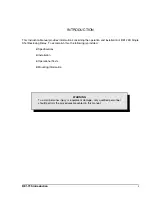
BE1-79S General Information
1-1
SECTION 1 • GENERAL INFORMATION
PURPOSE
The BE1-79S Single Shot Reclosing Relay is a solid-state device that provides automatic reclosure of circuit
breakers that have been tripped by a protective relay. Many faults are temporary and when a circuit breaker
has tripped, due to a protective system operation, it may be successfully reclosed after a short delay without
retripping. The BE1-79S Reclosing Relay will provide a single reclosure signal following a trip as an attempt
in restoring power and minimizing system disturbances.
DESCRIPTION
The Basler Electric Single Shot Reclosing Relay senses opening and closing of an associated circuit
breaker. If the reclosing relay has received a Reclose Initiate signal prior to the opening of the breaker, the
reclosing relay after a programmed interval will attempt to reclose the breaker. If the fault is not cleared, and
the breaker trips again, no further attempt is made by the reclosing relay to close the breaker. If reclosing
is successful and the breaker remains closed for a predetermined interval, the reclosing relay automatically
resets and is ready to attempt reclosing for a subsequent trip of the protected breaker.
The programmed time interval between breaker tripping and the reclosure attempt is continuously adjustable
by a front panel RECLOSE TIME control within three optional time ranges (0.1 to 2.0 seconds, 1.0 to 20
seconds, or 5 to 60 seconds).
A front panel RESET TIME control adjusts a reset timer in the relay over a range of 5 to 60 seconds. When
the reclosed breaker has remained closed over the reset interval, the reclosing relay will reset and provide
automatic reclosing for a subsequent protective trip. If the breaker trips before the expiration of the reset
interval, the reclosing relay will not attempt another reclosure. Resetting of the relay when this has occurred
requires closure of the breaker by other means and its remaining closed for the reset interval.
Automatic reclosing of a tripped breaker requires that a reclose initiate signal (RI) be generated by the
protective system and received by the reclosing relay prior to the breaker open signal (52b). The reclose
initiate feature allows the reclosing relay to distinguish between protective trips for which automatic reclosing
is required and those breaker operations for which automatic reclosing is not desirable. When this feature
is not required, the reclose initiate input may be connected to the system battery positive lead or relay ter-
minal 15*, depending on the specified contact sensing input type, to provide a permanent enable.
(*) This requires routing through the external sensing input module if the Type X power supply is used.
A reclose cancel signal (RC) may be applied to the reclosing relay to inhibit the reclosing operation. When
the reclose cancel signal is received, and a breaker trip occurs, the automatic reclose operation is inhibited
and the reclose output contacts of the relay do not close. Receipt of a reclose cancel signal will reset the
closing contacts regardless of the breaker position. The reset interval then times out when the breaker is
closed by other means to reset the relay. The reclose cancel signal provides a means of inhibiting automatic
reclosing of the breaker.
A wide range of options permit the relay to be specifically tailored to a variety of applications. Options are
available in the reclosing relay to provide a choice of three ranges for the reclosure time delay, and to
provide isolated or non-isolated contact sensing. The reclose signal to the controlled breaker may be
continuously maintained until breaker closure is detected or, optionally, may be maintained for a maximum
of 2-3 or 5-6 seconds or until breaker closure is detected.
A voltage monitor option permits active monitoring of a single phase of line and bus voltages to permit
reclosure if pre-selected live-line/live-bus, live-line/dead-bus, dead-line/live-bus and dead-line/dead-bus
voltage conditions are met. The measurable voltage input limits are adjustable over the range of 10 Vac to
135 Vac.
Summary of Contents for BE1-79S
Page 26: ...BE1 79S Installation 4 5 Figure 4 5 S1 Case Panel Drilling Diagram Semi Flush Mounting...
Page 28: ...BE1 79S Installation 4 7 Figure 4 8 Voltage Sensing Circuit Connections...
Page 29: ...4 8 BE1 79S Installation Figure 4 9 RI RC and 52b Sensing Circuit Connections...
Page 30: ...BE1 79S Installation 4 9 Figure 4 10 Internal Connection Diagram With Power Supply Status...






































